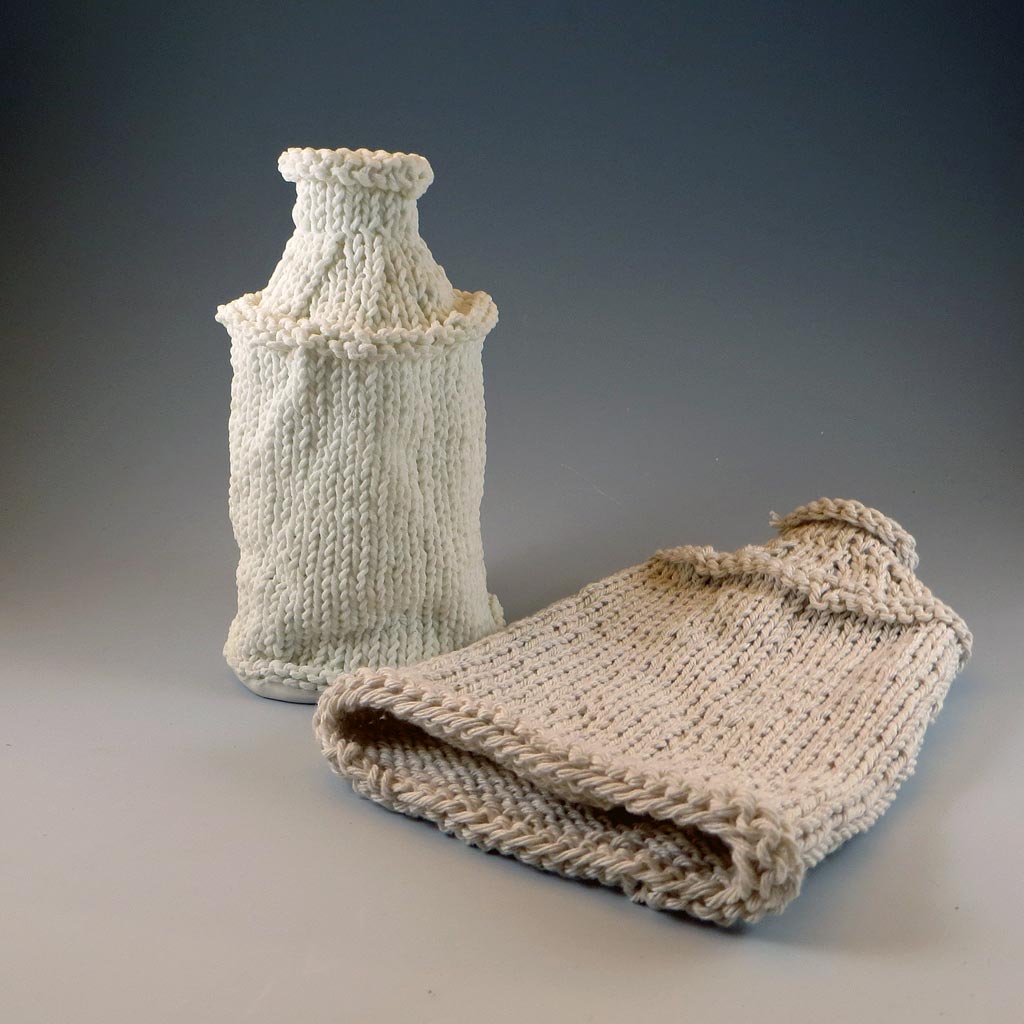
Well, we probably don’t spend a bit of time contemplating gauges and shrinkage, unless we have to, right? If you knit at all, you know that the size of your stitches matters. (Ask my Mom about my ginormous three-foot-long childhood Christmas stocking she handknit vs. my younger brother’s normal-sized one made from the same pattern after she attained the intended gauge.) And if you’ve fooled with clay some, you know you learn right away that its natural shrinkage as it dries and is fired both shocks (cracks! warpage!) and awes (it’s SO much smaller now!) Imagine dealing with both at the same time…and let me tell you about that.
First, let us explore the factors which impact the final size of your projects in each realm.
In The Fiber Arts – knitting included – an infinite range and interaction of variables affects the resultant gauge, including:
- The size of your yarn or, in my case my cotton twines. Fatter fibers generally = larger stitches = bigger work.
- The size of your needles. Bigger needles = larger stitches = bigger work. And, while there’s some leeway, needles which are too big or too small for the fiber affect the tightness or looseness of the finished fabric, which in turn affects its size, too.
- The stitch pattern – some patterns make a looser fabric naturally – laces, for example – and some pull in much tighter – cables, for example.
- Your personal “hand” : Do you knit British or Continental or Something Else? Are you consistent? Are you using your fingers, needles, hooks, or a machine? Are you angry, stressed, distracted, bored, tipsy? It matters.
That’s only four variables – times a zillion possible outcomes for combining them. Reining them all in so as to create a certain size of finished project, maybe even repeatability, takes discernment and effort relative to each one.
In the Ceramic Arts, with all its different clays and methods, again we find a long list of variables depending on:
- The clay body and its stated typical shrinkage percentage. And whether you have altered it in any way. In my case, that would mean whether I thinned or thickened my porcelain slip and what liquid/chemical I used to do that.
- Your construction method, whether wheel or hand built, or something else, and the variables within each, and, oh, your deft expertise in that method, too. (And probably all the similar impacts that your state of mind has with fiber, too.)
- Your final structure’s qualities and environment, including its thickness/thinness/porosity. Also, how fast it’s dried, including the temperature, the humidity and air movement around it.
- The temperature and atmosphere of the kiln it’s fired in, and how fast the firing went to temperature.
This actually amounts to way more than four variables, since each has its own subset and any one of them greatly affects your intended outcomes.
Testing in the Face of the Double Whammy
Now, with my knitted porcelain work, I deal with the boggling gauging and shrinkage contingencies for both fiber and ceramics. I’m still learning, and I’m here to affirm that the only way to predict outcomes at all is to test. Yeah, testing and keeping track of results adds a somewhat boring prophylactic quality to the joy of making, but hear me out.
In the fiber arts, it’s called a Gauge Swatch, which, sidetrack as it may seem, has a lovely WYSIWYG charm. Knit up a 4-5″swatch with the fiber, needles and stitch pattern you want and you shall see and be able to measure it directly. How does your swatch behave? Does it have a nice feel and drape or is it woefully floppy, or stiff and ornery? Does it pull in funny directions? Based on your swatch, how much knitting will need to go into a finished-sized version, and in my case, that is also knowing that the clay will have its way with it as well?
In ceramics, it’s called a Test Tile, meant to reveal the characteristics of a specific clay body’s response to shaping, texturing, drying and firing. Also, if needed, its behavior with specific glazes or decorating techniques. It takes time to go through the whole rigamarole, firing and all, but it ultimately saves major waste and heartache.
When a finished piece will be a product of both methods: knitted fiber turned into fired pure porcelain pieces, it’s the Double Whammy in action. Testing becomes a wise, proactive defensive act. Yet in either medium, your testing still only tells you so much. “Your mileage may vary” as they say, so when you combine the two, there are few certainties and zero guarantees. Yet, without testing, it’s like Yogi Berra once said, “You’ve got to be very careful if you don’t know where you’re going, because you might not get there.” With repeated and recorded gauge swatches and test tiles, at least you’re hacking a trail in the jungle undergrowth and letting some light in on your way.
Liz Crain – who, since last month’s missive, has not only knit up dozens of pieces of new work based on her confidence in her tests, she also helped her web customizer, ZapTuba, migrate this site to a spiffy new host, made it secure – got that “s” after the “http” – and switched to the seamless Stripe system for payments in the SHOP. Bet ya can’t even tell, right? Whew. But just like being proactive about the effects of gauges and shrinkage, it’s those supportive choices behind the scenes that contribute to quiet success. The better to create with, my dear.
And once again…you WOW me! When will we see your mastery in a hard bound edition? Even your photos have elevated the craft of magic meeting mud!
Dearest Noëlle, and once again you always wind up making me feel understood and fabulous! Magic meeting mud meeting mutual love…